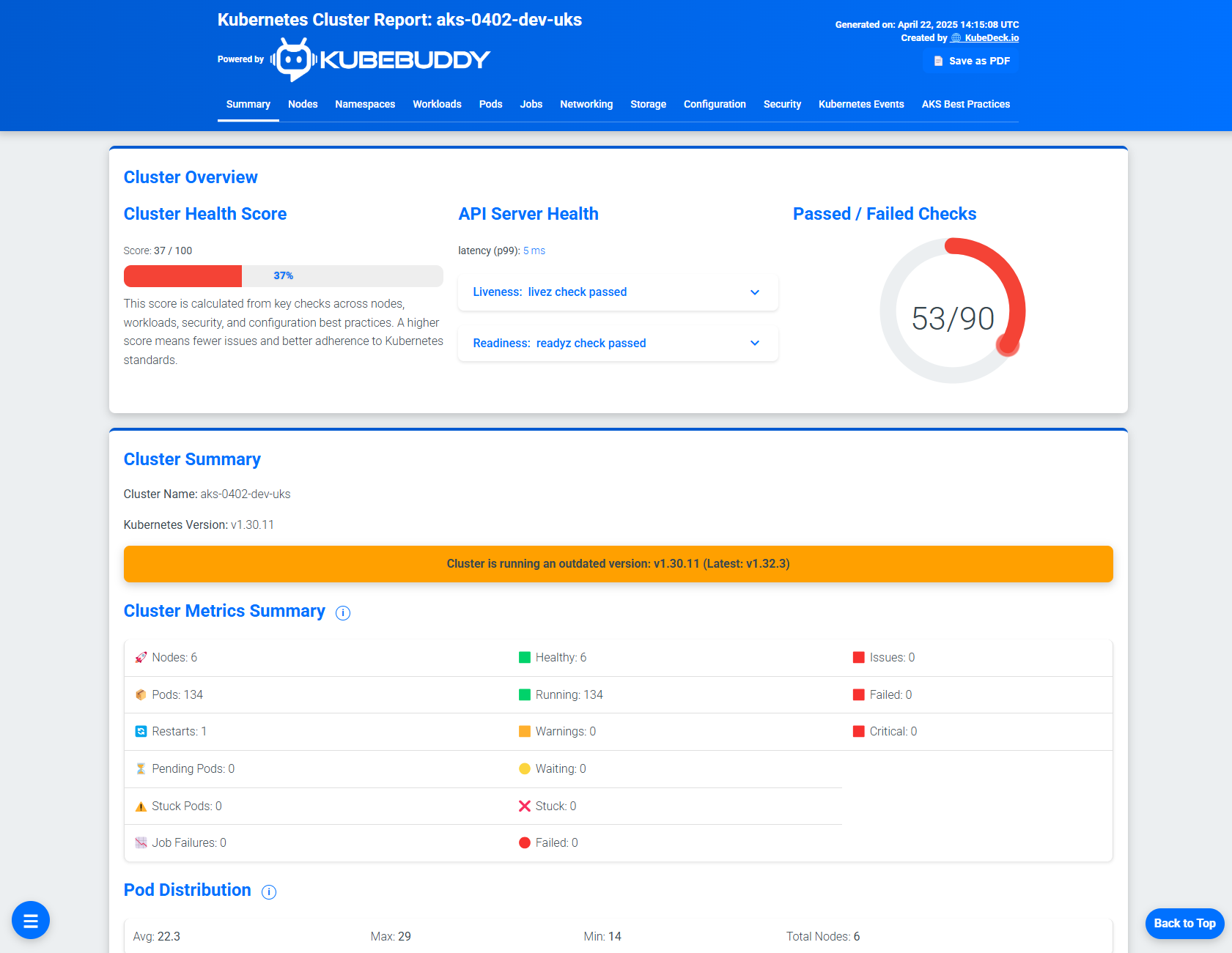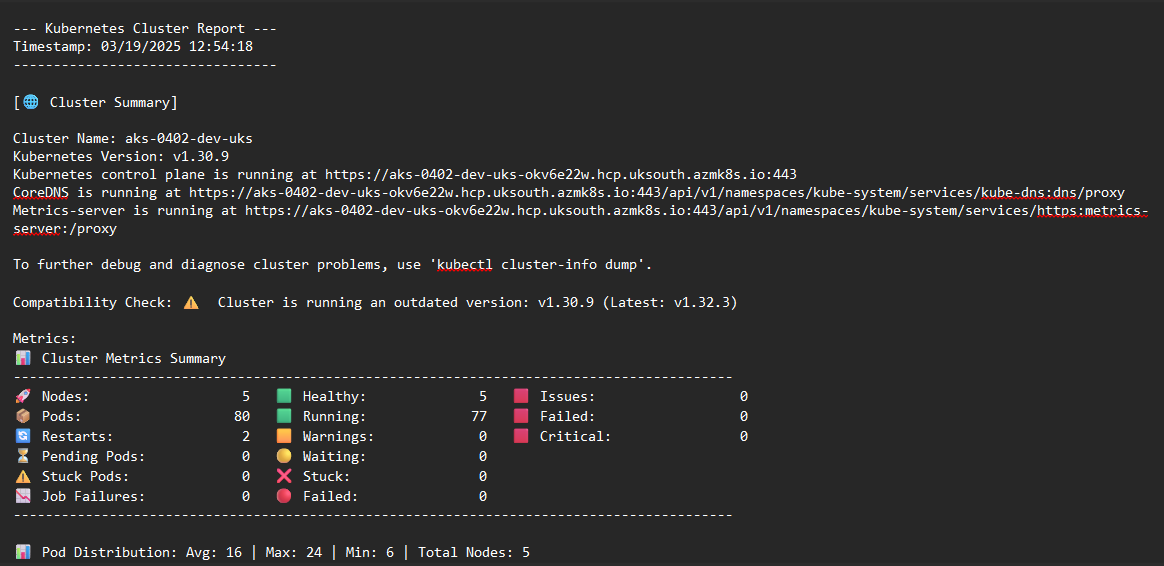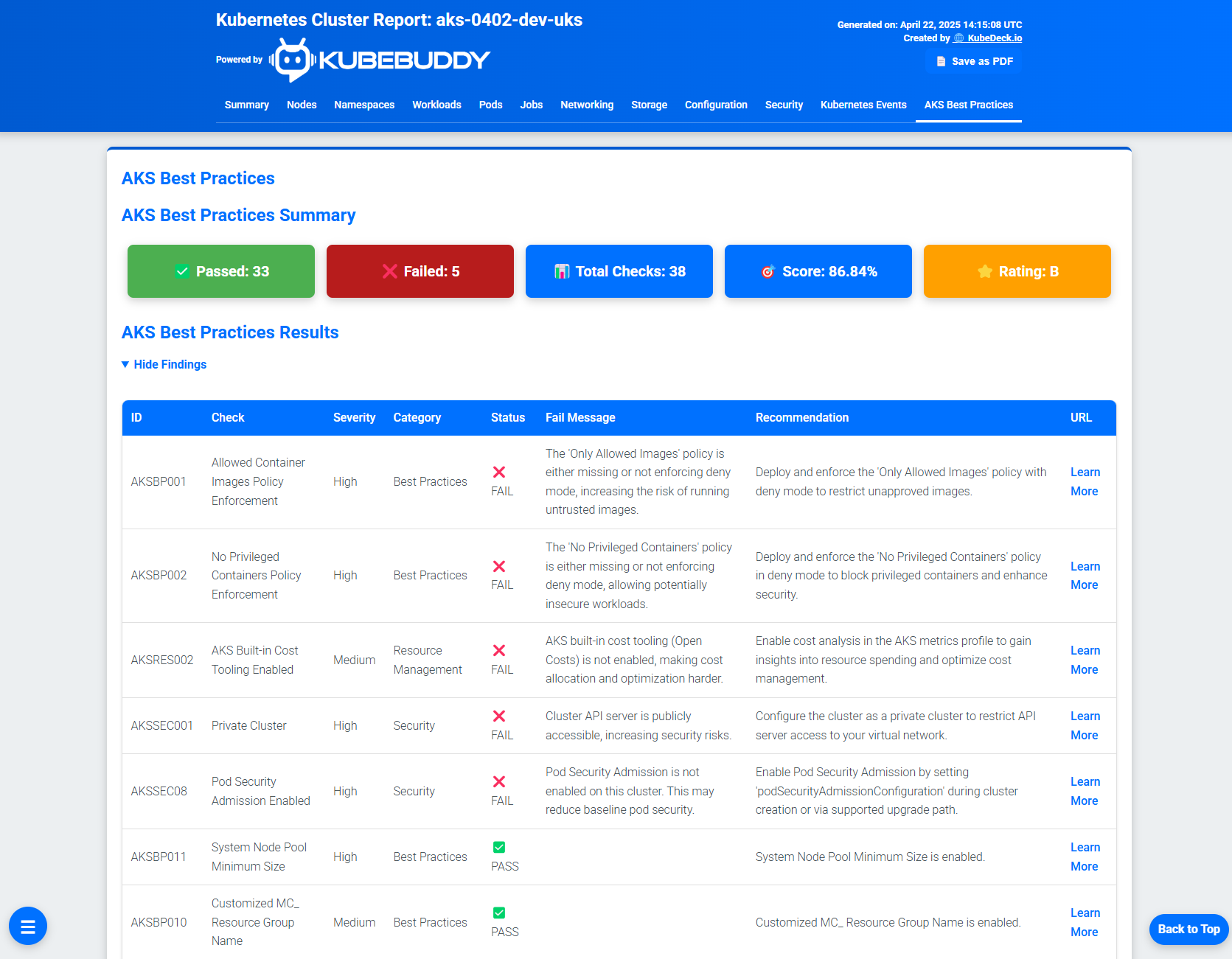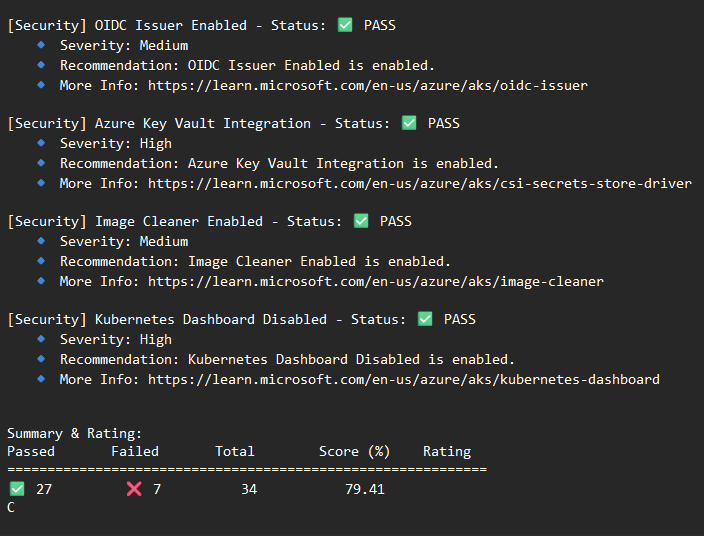PowerShell Usage¶
If you're using KubeBuddy powered by KubeDeck via PowerShell, this guide will help you monitor and analyze your Kubernetes clusters. Below are detailed instructions and examples for various commands.
🔧 Prerequisites¶
Before running KubeBuddy powered by KubeDeck, ensure you: - Are connected to a Kubernetes cluster/context. - Have kubectl installed and configured. - Have Azure CLI (az cli) installed if using AKS features. - Are logged into Azure and using the correct subscription for AKS monitoring.
(Optional) Enable AI Recommendations¶
If you’d like to use OpenAI to automatically generate enhanced recommendations, set your OpenAI API key as an environment variable:
$env:OpenAIKey = "<your-openai-api-key>"
KubeBuddy will detect this and enrich reports with AI-generated summaries and HTML guidance where applicable.
🔗 Related Guide¶
If you're running AKS checks or using the -Aks flag, see the full AKS Configuration & Best Practices Setup guide for prerequisites and role setup.
Available Commands¶
The following table provides a quick reference for KubeBuddy powered by KubeDeck commands:
| Action | Command Example |
|---|---|
| Run KubeBuddy powered by KubeDeck | Invoke-KubeBuddy |
| Generate an HTML report | Invoke-KubeBuddy -HtmlReport |
| Generate an JSON report | Invoke-KubeBuddy -jsonReport |
| Generate a text report | Invoke-KubeBuddy -txtReport |
| Generate reports with custom path | Invoke-KubeBuddy -HtmlReport -OutputPath ./custom-report |
| Run a KubeBuddy powered by KubeDeck with an AKS Best Practices Check | Invoke-KubeBuddy -Aks -SubscriptionId <subscriptionID> -ResourceGroup <resourceGroup> -ClusterName <clusterName> |
| Run AKS best practices check and HTML report | Invoke-KubeBuddy -HtmlReport -Aks -SubscriptionId $SubscriptionId -ResourceGroup $ResourceGroup -ClusterName $ClusterName |
| Run AKS best practices check and text report | Invoke-KubeBuddy -txtReport -Aks -SubscriptionId $SubscriptionId -ResourceGroup $ResourceGroup -ClusterName $ClusterName |
1. Running KubeBuddy powered by KubeDeck¶
To run KubeBuddy powered by KubeDeck on your Kubernetes cluster:
Invoke-KubeBuddy
This command provides a detailed menu-driven interface that allows you to navigate through various monitoring options. It analyzes node status, resource usage, workloads, and RBAC security settings.
2. Running KubeBuddy powered by KubeDeck with an AKS Best Practices Check¶
To check best practices for an Azure Kubernetes Service (AKS) cluster:
Invoke-KubeBuddy -Aks -SubscriptionId <subscriptionID> -ResourceGroup <resourceGroup> -ClusterName <clusterName>
You must provide your Azure Subscription ID, the Resource Group where your AKS cluster resides, and the Cluster Name.
3. Generating Reports¶
Generate an HTML Report¶
Invoke-KubeBuddy -HtmlReport

Generate a JSON Report¶
Invoke-KubeBuddy -jsonReport
¶
Invoke-KubeBuddy -jsonReport
Generate a Text Report¶
Invoke-KubeBuddy -txtReport

Customizing Report Output Path¶
You can specify a custom filename or directory for the report using -OutputPath.
Save report in a specific directory¶
Invoke-KubeBuddy -HtmlReport -OutputPath ./reports
./reports/kubebuddy-report-YYYYMMDD-HHMMSS.html
Invoke-KubeBuddy -jsonReport -OutputPath ./reports
./reports/kubebuddy-report-YYYYMMDD-HHMMSS.json
Invoke-KubeBuddy -txtReport -OutputPath ./reports
./reports/kubebuddy-report-YYYYMMDD-HHMMSS.txt
Generate report with a custom filename¶
Invoke-KubeBuddy -HtmlReport -OutputPath ./custom-report.html
./custom-report.html
Invoke-KubeBuddy -jsonReport -OutputPath ./custom-report.json
./custom-report.json
Invoke-KubeBuddy -txtReport -OutputPath ./custom-report.txt
./custom-report.txt
4. Running an AKS Health Check alongside the HTML report¶
To check best practices for an Azure Kubernetes Service (AKS) cluster, ensure you are logged into Azure and using the correct subscription:
az login
az account set --subscription <subscription-id>
Invoke-KubeBuddy -HtmlReport -Aks -SubscriptionId $SubscriptionId -ResourceGroup $ResourceGroup -ClusterName $ClusterName

5. Running an AKS Health Check alongside the JSON report¶
To check best practices for an Azure Kubernetes Service (AKS) cluster:
az login
az account set --subscription <subscription-id>
Invoke-KubeBuddy -jsonReport -Aks -SubscriptionId $SubscriptionId -ResourceGroup $ResourceGroup -ClusterName $ClusterName
5. Running an AKS Health Check alongside the txt report¶
To check best practices for an Azure Kubernetes Service (AKS) cluster:
az login
az account set --subscription <subscription-id>
Invoke-KubeBuddy -txtReport -Aks -SubscriptionId $SubscriptionId -ResourceGroup $ResourceGroup -ClusterName $ClusterName

6. Additional Parameters¶
| Parameter | Type | Default | Description |
|---|---|---|---|
-OutputPath |
String | $HOME/kubebuddy-report |
Folder or file name where report files are saved. Supports custom filenames. |
-Aks |
Switch | (N/A) | Runs AKS best practices checks. Requires -SubscriptionId, -ResourceGroup, -ClusterName. |
-SubscriptionId |
String | (None) | Azure subscription ID (used with -Aks). |
-ResourceGroup |
String | (None) | Azure resource group (used with -Aks). |
-ClusterName |
String | (None) | AKS cluster name (used with -Aks). |
-HtmlReport |
Switch | (N/A) | Generates an HTML report in -OutputPath. |
-JsonReport |
Switch | (N/A) | Generates a JSON report in -OutputPath. |
-txtReport |
Switch | (N/A) | Generates a text report in -OutputPath. |